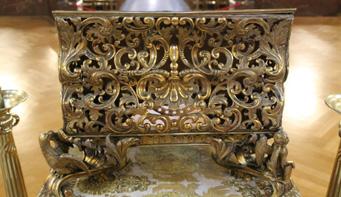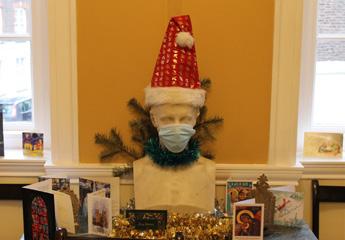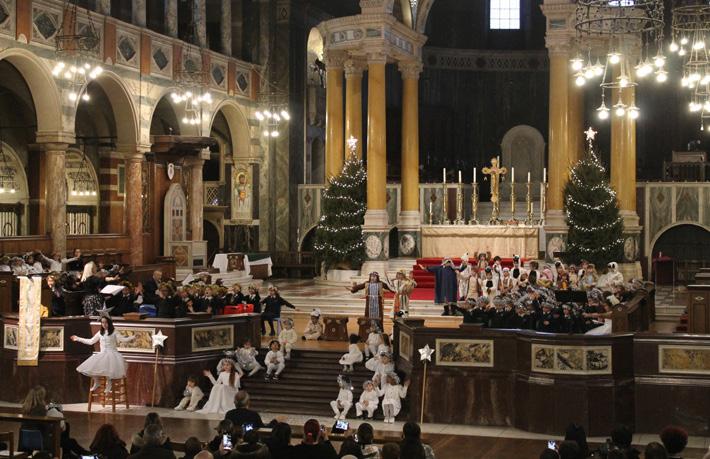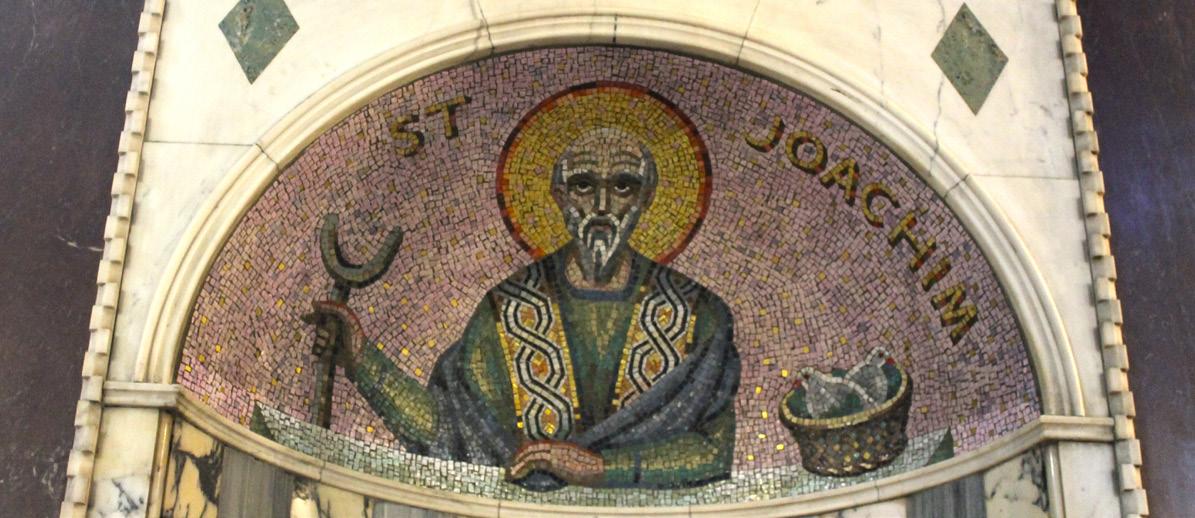
5 minute read
Monthly Album
A Promotion of Trees
The image show the sanctuary of the Cathedral all prepared for the celebration of Christmas. This year the trees were moved up from their previous location on ground level by the sanctuary balustrade so that they now flank the baldacchino, whose front two columns are enhanced by the display of the reliquiaries of (left) St Thomas Becket and (right) St Edmund of Abingdon. Fresh candles in the big six candlesticks, interspersed with a second shorter set, enhance the vertical aspect, whilst the very length of the high altar does not permit its significance to be in any way diminished in the overall view. We hope that Mr Bentley would be pleased.
A Missal Desk Brought Out from Storage

The Missal Desk that was used on the sanctuary during the Christmas season to display the Infant Jesus is recorded as having been given to the Cathedral in 1923 by Sydney Ernest Kennedy (1855-1933), who collected European works of art as well as Chinese porcelain. As can be imagined, it is of considerable weight, resting on four feet which are fashioned as symbols of the Evangelists. There is an accompanying metal missal cover, which we will show in a future edition of Oremus.

Cardinal Manning, Protected
We confess that at Christmas we do not treat the Clergy House Common Room’s bust of Cardinal Manning with the grave dignity which it deserves. He always wears a Christmas hat and, this year, a tinsel clerical collar to keep him warm against the draughts from the open windows. However, to preserve him from catching Covid from the Precentor, a face mask was added in token of our concern for his welfare.
SVP’s Nativity Performance
Here is an alternative view of the sanctuary, taken during the Grand Finale of the SVP School Nativity. The singing this year was particularly infectious, whence the swaying and arm-waving that can be seen, not to mention the quantity of congregational photography. At any rate, a good time was had by all.

The Canadian Air Force Memorial

The Chi-Rho memorial in the south transept; the nails are not as shiny now as when they were first installed
Patrick Rogers
The most unusual memorial in the Cathedral must be the Chi-Rho made of thousands of nails between the confessionals in the south transept. It commemorates the men of the Canadian Air Force who died in the Second World War. The first Canadian memorial, completed in 1947 and dedicated in 1948, consisted of an altar in the Baptistry in honour of St Anne, Our Lady’s mother and Canada’s Patron Saint. The altar, funded by £1,000 raised for the purpose, was set against the west wall below the windows and was clad with ornamental marble with a central cross on the frontal.
In 1967 Winefride de l’Hôpital, biographer and eldest daughter of the Cathedral architect, J F Bentley, died. Both she and an unmarried sister, Miss H M Bentley, who also died about this time, left bequests for the further decoration of the Cathedral. It was decided to use the money to complete the marble revetment of the Baptistry and work started in 1969. With Canadian approval, it was also decided to remove the Baptistry altar and transfer the dedication to a new marble altar facing the congregation in the centre of the Blessed Sacrament Chapel.
These decisions were, of course, taken in the light of the changes introduced after the Second Vatican Council (196265), one of which was the suggestion that the celebrant might face the congregation during Mass. However, a permanent new altar in the centre of the Blessed Sacrament Chapel would have radically altered the appearance of the Chapel and obscured the fine marble floor. The temporary altars introduced after Vatican II for use in the Cathedral (of which one remains for use in Cathedral Hall when Mass is celebrated there) were on aluminium frames, and so could be removed when not required.
When the scheme for the new memorial altar was abandoned, the next plan was for a plaque in the south transept. The man chosen by the Cathedral Art Committee to design it was David ‘Birdie’ Partridge, a naturalised Canadian born in Ohio in 1919. After serving in the Canadian Air Force as a flying instructor in 1942-1945, Partridge began as a painter and printmaker. In 1958 he produced his first three-dimensional sculpture comprising different sized nails; he developed and perfected this technique during his 10 years in London from 1962. He was deeply influenced by
St Joachim is on the liturgical north side of the side aisle and so receives some afternoon light, even in winter

early studies of geology and palaeontology and by hours of flying over Northern Ontario during the war, and this is reflected in his works now to be seen in galleries in Canada, Australia and the United States. His Vertebrate Configuration is in London’s Tate Britain.

St Anne has her niche immediately above the waiting penitents
The current Canadian Air Force memorial in the south transept was installed in 1972. It takes the form of a Chi-Rho (the first letters of Christ’s name in Greek) in thousands of shining nails of many different lengths. The central ‘X’ may also be viewed as commemorating the runways of a wartime airfield and the triple circle as the roundels or ‘bullseye’ markings on Canadian aircraft. The nails themselves may be taken to symbolise the 17,101 members of the Royal Canadian Air Force who never returned from the war. The inscription below is by Edward Wright. It reads: ‘To the Glory of God and in cherished memory of their beloved comrades this panel is erected by the Catholics of the Royal Canadian Air Force overseas. RIP.’ As the memorial sits immediately above one of the consecration crosses, a candle burns below it on 1 July each year, when we commemorate the Dedication of the Cathedral.
And St Anne, the patron saint of Canada? With her husband, St Joachim, they appear on either side of the near end of the south aisle – in niches, watching over the queue for Confession, and also in the first little mosaic tableau on the left of the Lady Chapel.

The site of St Anne’s altar is now a wide ledge below the Baptistry window. The Paschal Candlestick can be seen standing on what was, perhaps, the footpace of the altar? A design drawing shows a crucifix and four candlesticks on a ledge at the base of the window, whilst the altar itself has a marble frontal of three panels, the centre of these having a cross within a circle in contrasting colours.










